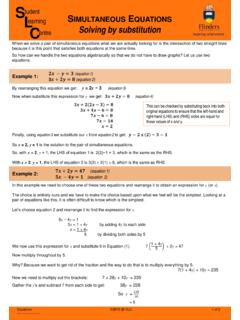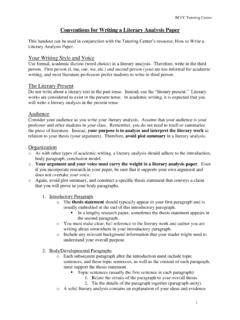Transcription of HARVARD REFERENCING - Flinders University
1 HARVARD - REFERENCING -6 _20220324 Page 1 of 11 HARVARD REFERENCING AGPS 6th Edition Student Learning Support Service, 2022 REFERENCING is a standard convention used by academic and professional communities to inform readers of the sources of information used in a piece of written work. There are many REFERENCING formats ( HARVARD , APA, MLA, Vancouver) and it is critical that you use the one prescribed by the people you are writing for. Check what style your College/topic requires. This quick guide covers how to reference common source types using the HARVARD Australian Government Publishing Service (AGPS) 6th edition.
2 For more examples of HARVARD AGPS 6th, consult the Style Manual: For Authors, Editors and Printers 6th edn by Snooks & Co, 2002 or The Standard for Australian Government Writing and Editing guide here It is important to note that HARVARD AGPS 6th is a REFERENCING style specific to the Australian Government and is different to other HARVARD REFERENCING styles. It is important to note that in Endnote, HARVARD style is not HARVARD AGPS6 style. This can be downloaded from In this guide, the general rule is given in red, followed by a highlighted, worked example. OVERVIEW When REFERENCING , you must cite all your sources in order to: acknowledge your sources allow the reader to verify the data / information allow the reader to consult your sources independently for their own purposes show the reader the depth and breadth of your reading References must be provided wherever you quote (use exact words), paraphrase (use other people's ideas using your own words), summarise (use main points of someone else's opinions, theories, or data), or use other people s data or figures.
3 Your references may be sources of information such as books, periodicals, websites, newspapers, government reports, legal cases, electronic recordings (CD, DVD, television), or brochures. Note that some of these sources are considered more credible than others. The main elements that need to be recorded in the HARVARD AGPS 6th system are the author, date, title and where the source is found. The HARVARD AGPS 6th REFERENCING system consists of two components, both of which are required: 1. THE IN-TEXT CITATION This is the short in-text reference to the source of the information , Maguire (2018, ) or (Maguire 2018, ).
4 2. THE REFERENCE LIST This is a list at the end of the written text of all references cited within. It contains all the details of the reference rather than the short version used in the in-text citation. One item might look like this: Maguire, E 2018, Girls, autobiography, media: gender and self-mediation in digital economies. Palgrave Macmillan, Cham, Switzerland. FORMATTING Formatting instructions in The Style Manual: For Authors, Editors and Printers 6th edn suggest that decisions regarding line spacing, font style and size be made with the intended audience in mind. It is advised that you check for specific formatting requirements in your assignment instructions and rubric or ask your marker for further clarification.
5 HARVARD - REFERENCING -6 _20220324 Page 2 of 11 HARVARD REFERENCING AGPS 6th Edition Student Learning Support Service, 2022 The purpose of an in-text citation is to show the reader where the idea you are using has been sourced. This serves two purposes. Firstly, it shows how you have used the literature to inform and support your statements and, secondly, it provides enough information that the reader can find this reference (with full reference details) in your reference list. A HARVARD AGPS 6th in-text citation includes: The author s last name (or authoring body or organisation).
6 The year of publication (if no date can be found, use (meaning no date ). The page number(s) when you re using a direct quotation , REFERENCING images, figures or data, or referring to multi volume works. While not mandatory, you are often expected to include page numbers when paraphrasing, particularly when the information is from one or multiple specific pages. Use p. for one page and pp. ( , pp. 34-5) for more than one page. Page numbers are not required when referring to the general theme of a work. If there are no page numbers, include only the author s last name and year of publication in-text.)
7 When an electronic source lacks numbered pages, your citation should include (if possible) information that will help readers locate the particular passage being cited. When a document has numbered paragraphs, use the paragraph number preceded by the abbreviation "para." (or paras. plural). FORMATTING IN-TEXT CITATIONS AUTHOR PROMINENT VS INFORMATION PROMINENT CITATIONS The location of these citations within the sentence will depend on the form of in-text citation being used. In-text citations can take one of two forms: Author prominent citation: this is when the citation is a necessary part of the sentence.
8 The author or work is introduced using a signal phrase and the brackets go around the year only. Information prominent citation: this is when the citation stands separate from it in brackets. For example (author prominent citation): Smith (2003, p. 4) emphasised the need for an understanding of soil condition. For example (information prominent citation): There is a critical need to understand soil condition (Smith 2003, p. 4). WHEN TO USE AND OR & WITH MORE THAN ONE AUTHOR If you re using an author prominent citation (the authors names are part of your sentence), use the word and between the last two authors.
9 If you re using an information prominent citation (the authors names are inside the brackets), use an ampersand, & . Jones and Chan (2002, pp. 30-1) have shown that .. A recent study (Jones & Chan 2002, pp. 30 -1) has shown that .. IN TEXT CITATIONS HARVARD - REFERENCING -6 _20220324 Page 3 of 11 HARVARD REFERENCING AGPS 6th Edition Student Learning Support Service, 2022 The table below refers to both hard copy and electronic sources. A guide to HARVARD AGPS 6th in-text citations can be found at: quotation - BASIC FORMAT Quotes should appear word-for-word the same as the original and be enclosed in quotation marks (.)
10 For an author prominent citation, introduce the quotation with a signal phrase that includes the author's last name followed by the date of publication and "p." for one page or pp. for two pages in parentheses. Hart (1996, p. 109) wrote that some primatologists "wondered if apes had learned Language, with a capital L". For an information prominent citation, place the author's last name, the year, and the page number in parentheses after the quotation . Use commas between items in the parentheses: Some primatologists "wondered if apes had learned Language, with a capital L" (Hart 1996, p.)








